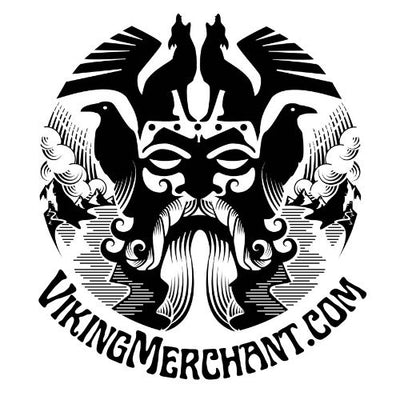Viking Engagement and Marriage Practices
Posted by Amber Lee on
When envisioning the Vikings, many of us conjure up images of battle-hardened warriors, intrepid explorers, and elaborate sagas. However, beyond their raids and adventures, the Vikings had a rich tapestry of traditions, especially when it came to engagements and marriages. Today, we'll set sail on a journey exploring the intimate rituals of love and commitment in Viking society.
Marriage among the Vikings wasn't just a union between two individuals but was often an alliance between families or clans. While love stories certainly existed, many Viking marriages were arranged by families, taking into consideration land ownership, political ties, and family standing.
Bridal Price (mundr): Akin to a commitment fee, the groom provided the bride's family with a bridal price. This wasn't a purchase but an affirmation of the groom's capability to care for their daughter.
Dowry's Assurance (heiman fylgia): To balance the scales, the bride's family equipped her with a dowry. This acted both as her inherited wealth and a security net, ensuring she had resources if adversity struck.
Symbolism and Rituals
The Vikings deeply cherished symbols and rituals, infusing them into their engagement and marriage practices.
-
Sword Exchange: In a poignant ceremony, grooms presented their brides with ancestral swords, symbolizing the lineage and heritage the bride was joining. Conversely, the bride's gift of a sword to the groom signified her family's protective mantle extending over him.
-
Arm Rings and Betrothal: While we wear engagement rings on our fingers today, Viking couples exchanged arm rings or bands. These were not mere ornaments but tokens of commitment, publicly declaring their intent to wed.
Celebratory Feasts
Following the engagement, a feast, often grand and elaborate, was organized. This wasn't just about merriment; it was a public declaration of the impending union, with both families coming together, showcasing unity and shared joy.
The Thing Assembly
Viking society was well-organized, with local assemblies called "things" that governed legal and social matters. Engagements, agreements, and sometimes disputes related to marriages might be presented here, lending an official seal to the union.
Wedding Ceremonies: A Grand Affair
Engagements usually led to weddings within a year. The wedding was a significant event, marked by the bride donning a bridal crown, symbolic rituals, blessings from elders, and, of course, a grand feast celebrating the union.
Weddings in Viking culture were more than just a union between two individuals. They were elaborate events, blending sacred rituals, societal traditions, and celebrations that lasted several days, emphasizing the significance of marriage in their community.

The Viking bride was the centerpiece of the ceremony, adorned in her best attire. She wore a long dress, often with detailed embroidery or beadwork reflecting her family's status. The most significant piece of her ensemble was the bridal crown, often made of metal and embellished with intricate designs, sometimes accompanied by pendants that hung by the temples.
Before the ceremony commenced, there was a procession, leading the bride and groom to the sacred space, often outdoors, where the rituals would take place. The choice of location was essential, sometimes near a significant tree or stone, aligning with the Norse reverence for nature and its spirits.
The Norse pantheon was integral to Viking weddings. Sacrifices, usually in the form of animals, were made to gods like Thor, for protection, and Freyja, the goddess of fertility, to bless the couple. These rites were performed by a goði (priest) or gyðja (priestess) who invoked the gods and sought their blessings for the union.
Similar to many cultures, Vikings exchanged rings during their wedding ceremony. However, these were typically arm rings or bracelets. Along with the exchange of rings, the couple exchanged vows. These vows were personal, promising loyalty, protection, and shared responsibilities.
After the formal ceremony, a grand feast followed. It was a lavish affair with music, dance, poetry recitals (sometimes in the form of skaldic verse), and an abundance of food and mead. The feast could last for days, reflecting the economic and social standing of the families involved.
-
One of the most lively parts of the Viking wedding was the "Brullaup run," a race between the bride and groom's families. The two groups would race to the wedding feast, and the losers would serve the winners alcohol throughout the night, adding a touch of fun and competition to the celebrations.
To conclude the wedding celebrations, there was a symbolic bedding ceremony. The couple was escorted to their bed by a group of young men and women, emphasizing fertility and the couple's future together. While this ritual might seem intrusive by modern standards, in Viking culture, it was an essential rite, underscoring the community's collective investment in the couple's union.
Viking wedding ceremonies were a harmonious blend of the sacred and the celebratory. They highlight the societal importance of marriage and the multifaceted rituals that emphasized commitment, fertility, protection, and community.
Viking engagements and marriages offer a fascinating glimpse into a society where tradition, symbolism, and practical considerations seamlessly intertwined. While their practices might seem distant from our contemporary customs, the underlying themes of commitment, family, and unity resonate universally. The next time you wear a piece of jewelry or partake in a wedding ceremony, remember that echoes of such traditions have been reverberating through time, from Viking longhouses to modern wedding halls.
